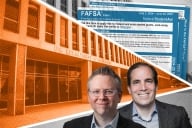You have /5 articles left.
Sign up for a free account or log in.
When community college leaders gather these days, one topic that seems to come up all the time is what to do about declining male enrollments. Nationally, men make up 43 percent of college students, and there are plenty of community colleges where that proportion is smaller.
On Tuesday, the efforts of one such institution -- St. Petersburg College -- were described to a very engaged audience at the annual meeting of the National Institute for Staff and Organizational Development, in Austin. With male enrollment down to 39.7 percent at the ethnically diverse (half white, half other groups) Florida college, Rod Davis has been moved from a position as academic advisor to coordinator of the Male Outreach Initiative, and he described the process of putting together such a program.
In part, he said that the college didn't want to re-invent the wheel, so it's been looking at what other institutions -- in and out of academe -- are doing. For example, in talking to those who enlist in the military, Davis said it was clear that the way the military is reaching students is getting involved in middle schools and high schools early, with military recruiters volunteering with sports teams and building relationships early -- without an explicit recruiting agenda. Davis said that if the military can succeed at this -- even at a time of war -- surely colleges can.
St. Petersburg has also been doing focus groups with male students to ask them what issues most challenge them at the college, and those discussions are leading to the creation of other programs. For example, many students at the college hold substantial work commitments -- and about one-third have jobs of at least 40 hours a week. Many of the students' employers have tuition reimbursement programs, but the college found that male students in particular didn't know about them, or how to get access to the money to which they are entitled. So the college has started bringing in human resources officials from major employers to talk about benefits such as tuition reimbursement.
Similarly, he said that many male students with jobs are unaware of flextime policies in place at their employers that would ease the balance of college and work.
Davis said that the tuition reimbursement example is typical of the issues faced by male students -- practical problems hinder their success and they don't know how to deal with them. "Men know where they want to go, but have no ideas about how to get there."
He said, for example, that when pressed, male students talked about not buying textbooks that are assigned, because of their cost, prompting the college to create a textbook-sharing program. With gas prices reaching record levels, Davis said male students in particular are raising questions about transportation, so the college is working with local transit authorities on bus passes.
A related problem is that male students are less likely to be communicative about what their issues are -- unless asked directly. Male students will end up having several meetings with an academic or financial aid counselor before revealing what is really on their mind, he said. The male students appear to be more willing to be open with male counselors, so the college is trying to make sure staffing is balanced on gender.
St. Petersburg College is also doing a lot of research on retention patterns and trying to share the results with academic counselors. For instance, Davis said that for male students on average, distance education isn't wise in their first year, as drop-out rates are high.
"A lot of this is about knowing your students," Davis said.







